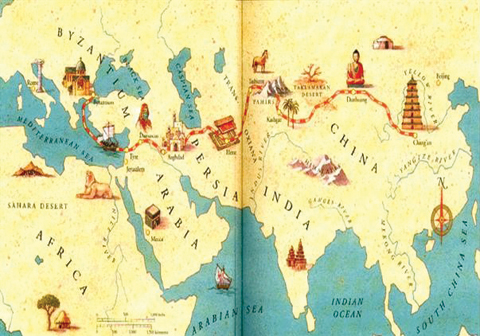 The most important landmarks and civilizations that pass through the Silk Road.
The most important landmarks and civilizations that pass through the Silk Road.KUWAIT: The ancient Silk Road, an intercontinental network of trades routes that linked nations with different cultures, can once again contribute to the boom of human civilization. With an estimated total length of 15,000 kilometers, this network consists of several land and maritime routes across various regions in Eurasia and Africa from China in the Far East to central Asia, Persia and Arabian Peninsula, and further to Europa and North Africa in the west.
Trade convoys in the past used to take several months to reach their final destinations. The main traders were Chinese, Arab Turkmens, Indians, Persians, Somalis, Greeks, Syrians, Romans, Georgians and Armenians. Besides the trade exchanges, the silk road played a key role in bringing nations with different cultures close to each other and promoting their economic prosperity, and boosting studies in humanities.
Cultures and traditions
Tradesmen had to learn the languages, cultures and traditions of the people living along this network of roads, and know about the political developments and the dynasties of the cities, states and regions where they do business. In the course of time, cities located along the Silk Road prospered thanks to the guesthouses and restaurants built there to cater for tradesmen and travelers. Though the historical network of trade routes was discovered by the Chinese Han Dynasty (130 BC - 220 AD), the terms 'Silk Routes' or 'Silk Road' became common among historians only in late 19th century; they were coined by the German geographer Ferdinand von Richthofen who referred to them as ' Seidenstrasse' (Silk Road) or 'Seidenstrassen' (Silk Routes) in 1877.
Richthofen derived this term from the community monopolized by China for nearly 3,000 years. During this long time, the Chinese rulers used to execute anybody who ventures revealing the secret of the silk industry to an alien nation. The outstanding technical and cultural achievements of this network is the spread of the paper and printing industries and the flourish of scientific researches in such areas as geographical and archaeological explorations. This network carried not only goods but ideas, beliefs and traditions as well; it linked great civilizations Eurasia, the Middle East and Africa. According to historic references, the town of Chinag was considered the start of the Silk Road. Its natives were first among the peoples of China to embrace Islam by the Arab traders.
The Arabs played a pivotal role in the commerce on the Silk Road due to their countries' location between Asia and Europe. Islamic cultures and arts had gradually spread in China and many natives embraced Islam.
The Chinese ties with the Islamic nation date back to the eighth century when the Islamic empire spread eastwards and westwards, reaching the western borders of China. The Chinese in the beginning of their trading with the Arabs used to call the precious gems 'pebbles of the Arabs,' because they believed that the Arabs' lands were covered with these jewels.
Large effect
The Silk Road had largely affected ancient civilians, namely those of the Indians, the Egyptians and the Romans. When wars and bloody conflicts spread, many traders shifted to sea routes to pursue their trades. This led to great discoveries of new lands. The Silk Road had faded due to a number of reasons, such as mushrooming conflicts, great discoveries and the Turks' closure of the Suez Canal in 1869. The road reappeared between Asia and Europe in 2005, but this time with railways, stretching more than 10,000 kilometers.
In 2013, China launched the initiative, 'the belt and the road' with a new bid to strengthen its interactions with the world and boost global trade. China aspires that the grand project, forecast to cost billions of dollars, will link the nation with more than 60 states in Asia, Europe and Africa. On January 18, the first train loaded with Chinese products, part of this project, arrived in the British capital crossing 12,000 kilometers from China. - KUNA










